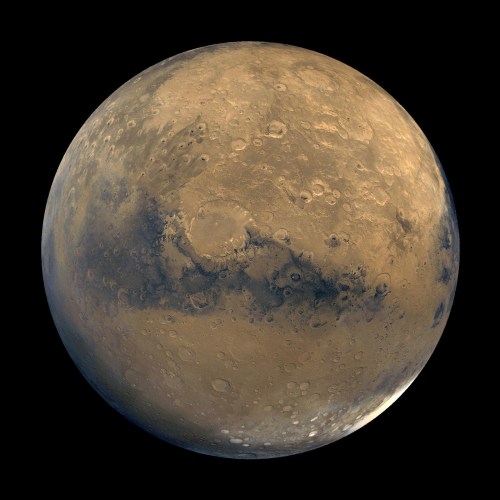
Scientists agree that once, billions of years ago, Mars had liquid water on its surface which formed lakes and oceans. It may even have looked similar to Earth once upon a time. But over time, that water was lost, and Mars is now a dry, arid place. Water exists there only in the form of ice near its poles and in tiny quantities of water vapor in its atmosphere.
The question that remains is: How did this happen? Where did Mars’s water go? The generally accepted theory is that its water evaporated away into space, in a process called atmospheric escape. Billions of years ago, when sunlight hit the planet it warmed the water there, which rose into the atmosphere as vapor. Winds carried this vapor to the poles, where ultraviolet radiation from the sun split it into hydrogen, which then escaped into space. Over time, water was lost this way.
But now, a new piece of research is challenging this theory. It has found that a significant amount of water is trapped in minerals in the planet’s crust, meaning that it didn’t escape into space. With oceans estimated to be between 100 and 1,500 meters deep, there would have been too much water for atmospheric loss to explain where it all went.
“Atmospheric escape doesn’t fully explain the data that we have for how much water actually once existed on Mars,” said lead author Eva Scheller in a statement.
The researchers don’t disagree that atmospheric escape happened — but they do think this process was supplemented by water being trapped in minerals in the crust. Water interacts with rocks to form clays, in a similar process to what is seen on Earth. The difference between here and there is that Earth has an active interior with plate tectonics, so rocks are churned up and recycled and their water is released back into the system. On Mars, the interior of the planet is largely inactive so these rocks don’t release their water.
“The hydrated materials on our own planet are being continually recycled through plate tectonics,” said Michael Meyer, lead scientist for NASA’s Mars Exploration Program in the statement. “Because we have measurements from multiple spacecraft, we can see that Mars doesn’t recycle, and so water is now locked up in the crust or been lost to space.”
Editors' Recommendations
- NASA selects 9 companies to work on low-cost Mars projects
- NASA is looking for volunteers for yearlong simulated Mars mission
- Watch Sierra Space blow up its LIFE habitat in dramatic pressure test
- The moon may be 40 million years older than we thought
- Map of Mars shows the location of ice beneath the planet’s surface